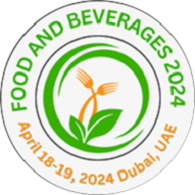Welcome message
The 33rd World Conference on Food and Beverages invites you to Dubai, UAE on April 18-19, 2024. This two-day conference features plenary lectures, parallel sessions, poster presentations, and our perennially popular Workshop activities, with something for everyone in the food and beverage industry. This two-day event will offer plenary lectures, parallel sessions, poster presentations, and our ever-popular "Workshop" events, with something for everyone in the food and beverage business.
Food Conference A jam-packed schedule is promised for 2024, including a full assessment of our 2023 Global Trends Report, best practice guidance from knowledgeable industry experts, an electrifying keynote address, first-hand customer stories, and an engaging panel discussion. Hear from recognized professionals and thought leaders who understand the challenges your company is experiencing and how to overcome them.
Are you ready to learn more about what to expect and how to prepare for upcoming changes?
Target Audience
-
University Academics, Faculty, Staff, and Students
-
Members of the Board of Directors, Presidents, Vice Presidents, and Directors
-
Associates in Nutrition and Food Science Food Scientist Officers in Charge of Food Safety and Health Holistic Dietician.
-
Sports Nutritionists and Clinical Dieticians Business Owners, Entrepreneurs, Associations, Societies, Nutritionists, Dietitians, and many others.
Why to attend
Benefits of attending:
-
By attracting 30000+ users and 50000+ views to our collection of abstracts, our aggressive online marketing attracts speakers and academics to our conference.
-
Engage in conversation with the hundreds of influential professionals shaping the food and beverage industry in 2024.
-
Each conference participant will have a specific reason for participating in one-on-one interactions with eminent speakers and renowned keynote speakers.
-
During our keynote lectures, you will have a wonderful opportunity to hear what the foremost authorities in the fields of food and beverage are discovering.
-
You will gain experience and competence in creating strategic abilities that are valuable in golf, leading to an incredible number of acknowledged such pros. Schedule for the intensive conference on food and beverages in 2024.
-
Nomination for the best poster award.
-
Honor for Outstanding Young Researchers
Why Exhibit ?
-
Boost sales
-
Introduce new products
-
Describe your company
-
Meet fresh suppliers and business partners.
-
Establish important connections
-
Educate academia and food institutions
Market Analysis
Food & Beverages Market Overview
The size of the global food and beverage market is anticipated to reach $7,464.2 billion by 2027 and is expected to expand at a CAGR of 5.9% from 2022 to 2027. The market for food and beverages is expanding as a result of shifting consumer preferences, an increase in shopping centers, out-of-town retail parks, and retail establishments. Food Navigator estimates that the market for natural and organic food and beverages in the United States will reach $300 billion in sales by 2024 and $400 billion by 2030. During the projection period of 2022–2027, this increased demand for organic food & beverages will drive market expansion. Innovative, wholesome, and delicious foods and beverages are popular in the international food and beverage market. The global market for food and beverages is divided into categories like alcoholic beverages, non-alcoholic beverages, grain products, bakery & confectionery (snack foods, baked goods, and staple foods), frozen, canned & dried food, dairy food, meat, poultry, & seafood, syrup, seasoning, oils & general food, animal and pet food, tobacco products, and other products. Additionally, market growth is fueled by the global presence of major market competitors, their new product launches, and the popular 'try it' movement. According to the Forbes 2022 estimate, Nestle leads the food and beverage sector with more than $93 billion in sales, followed by Pepsico. Nestle, a pioneer in plant-based nutrition, announced in February 2022 that it had acquired the majority of the shares in Orgain and More
Past Conference Report
ConferenceSeries hosted the event “32nd world Conference on Food and Beverage” at London, UK during June 05-06, 2023 . The conferences were organized with a focus on the themes “Fresh recipes for the food and beverage industry” was a great success where eminent keynote speakers from various reputed companies and Universities made their resplendent presence and addressed the gathering. The event proceedings were carried out through several Scientific-sessions and plenary lectures, ConferenceSeries would like to express a sincere thankfulness to all the Honourable guests and Keynote Speakers of 32nd world Conference on Food and Beverage. We would like to convey a warm gratitude to all the Honourable guests and Keynote Speakers of Food & Beverages 2023.
Food & Beverages 2023 committee would like to convey a warm gratitude to all the Honourable guests and Keynote Speakers, Yongmin Xiong
from China director of the Endemic Institute of Xian Jiaotong University China; Ngoc Minh Quynh Pham from Uruguay Lecturer and researcher at Nha Trang University Uruguay ; Gary Stoner from Medical College of Wisconsin USA; Joan Cook-Mills from Northwestern University School of Medicine USA ; Kenneth Olson from Life Sciences Technologies International USA; John Ellis Agens from Florida State University USA have given a wonderful talk which makes allows the delegates and other attendees to gain the knowledge about main course of the event.
Food & Beverages 2023 Organizing Committee would like to thank the Moderator of the conference, Gary D. Stoner from Professor Montana State University USA, who contributed a lot for the smooth functioning of this event and for taking up the responsibility to coordinate during the sessions for smooth functioning of this event. We are indebted to your support.
ConferenceSeries/ Lexis conferences also took the privilege of felicitating Food & Beverages 2023 Organizing Committee, Keynote Speakers, Plenary Speakers, Chairs and Co-Chairs, Young Researchers and other attendees whose support made the conference a great success.
We also would like to thank all our Speakers, Poster Presenters and Delegates for taking out your time and sharing their research work with our peer network. We are very glad to have shared a great relationship with all these Attendees, associations and we hope to see even greater support in our upcoming events. We would also like to thank Chairs and Co-chairs of the conference, Gulhan Unlu from Associate Professor University of Idaho USA; Gustavo Barbosa-Canovas from Professor Washington State University USA; Yuanlong Pan Principal Research Scientist Nestle Purina Research Center
USA for a being a great support for our event to be a grand success.
A series of lectures by distinguished professionals discussed the recent trends and issues in inter-disciplinary Rheumatology and its technical advancements.
Save your dates for the most awaited event of 2023
With a great response and feedback which we received from participants and supporters from Food and Beverage 2023, we are proud to announce our upcoming conferences in the Series 33rd World Conference on Food and Beverages Technology on January 11-12, 2024 in Dubai, UAE with the theme of Fresh Recipes For The Food And Beverage Industry.
Some of our conference images are as follows:
The main aim of this conference is to solicit the gracious presence of our honourable, to the upcoming conference “33rd World Conference on Food and Beverage” that is going to be held during January 11-12, 2024 in Dubai ,UAE to share and exchange their knowledge.
It is an International platform for business delegates, B2B meetings, poster presentations, workshops, symposia, networking and more. It will offer a platform wherein you can ensure enormous exposure and networking by exhibiting products and services. Grab the opportunities, and share your innovative ideas, new technologies and Recent researches.
Food and Beverage 2024 witnesses an amalgamation of peerless speakers who enlightened the gathering with their contribution towards the prevention food and beverage.
For being a Experts in Food and Beverages, we hope that this platform gives knowledge and new updates by undergoing with the several interactive sessions to encourage the exchange of innovative ideas in the field of Food and Beverage and its advancements, in that all the session talks are consider to be a great talks which makes the delegates, exhibitor, collaborators and other speakers feels so much interesting.
Being a significant expert in this area we would like to Invite you as an International Organizing Committee Members, Speakers, Keynote speakers, Young Research forum, Sponsors and Exhibitor, etc for Food and Beverage 2024. Our goal is to deliver an outstanding program which covers the entire spectrum of research & innovations in Food and Beverage experiences of various principles and practices.
The centre of the activity of Food and Beverage 2024 is to produce the clear visual definition by undergoing with Oral Presentation, Poster presentation, Workshop, Exhibition, networking and interacting session
With the feedback from your renowned Speakers, we have added some of the new Session tracks that needs to be focused such as such as Beverage Technology, Dairy Science $ Technology, Food Packaging and Preservation, Food Waste, Food and Resource Economics, Food ,Nutrition and Health, Beverage Technology, Chemistry and Biochemistry of Food, Food and Beverages Hotel Management, Food Borne Illnesses, Food Consumer Science, Food Nanotechnology, Food Security and loss, Processing and Technology in Food and Quality Control and Quality Assurance of Food,With the great support we have successfully completed Food and Beverage 2023 and we are expecting huge response and support from the Food and Beverage Professionals, Young researchers, Students, Delegates, Directors and other Food and Beverages related companies to have your gracious presence at Food and Beverage 2024 on January 11-12, 2024 in Dubai, UAE to make this congress a great successful event of the year 2024
Join our team Food and Beverage 2024 at this beautiful city of United Kingdom and let’s make this professional gathering a Great success
Contact us:
Alena Smith | Program Manager
Food and Beverage 2024











